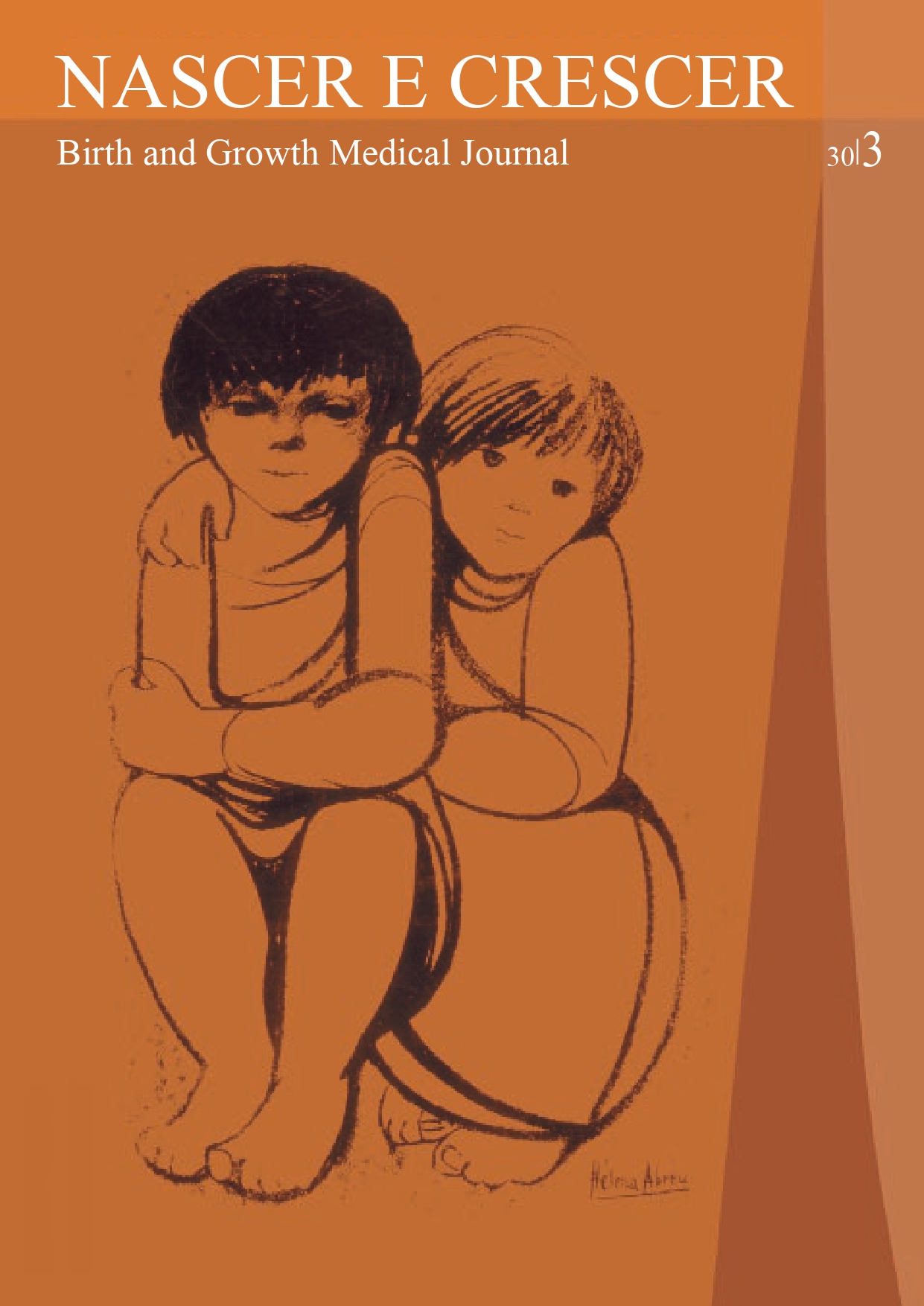After pediatric stroke, it’s time to enable!
DOI:
https://doi.org/10.25753/BirthGrowthMJ.v30.i3.17949Keywords:
functionality, neuroplasticity, pediatric, perinatal, rehabilitation, strokeAbstract
Introduction: Although rare, pediatric stroke is more common than one may think. Deficits may not be evident in the short term but emerge months or years later, when psychomotor development, educational, and social requirements increase.
Aims: To characterize the pediatric population with stroke followed at the Physical and Rehabilitation Medicine (PRM) consultation in a tertiary center and compare it with data in the literature and review the evidence on pediatric stroke rehabilitation care.
Material and Methods: This was a retrospective study focusing on the first observation of stroke patients followed at a pediatric PRM consultation over 12 months. Gender, age, type of stroke, vascular territory, risk factors, functionality, event recurrence, and mortality were assessed. A bibliographic search was conducted on PubMed and Medline using the keywords ‘stroke’, ‘pediatric’, ‘perinatal’, ‘neuroplasticity’, ‘functionality’, and ‘rehabilitation’. Inclusion criteria comprised meta-analysis, systematic review, and review type of studies, written in Portuguese and English languages, and focusing human studies.
Results: The study included 42 patients, 25 of whom were male (60%). Perinatal stroke was reported in 33 patients (13 in the prenatal period and 20 up to 28 days of life). Ischemic stroke was reported in 35 cases (83%), with the middle cerebral artery being the most affected vascular territory in 29 cases (69%). Fifty percent of patients had known risk factors, specifically prematurity in 21%. Fifty to 75% of patients had high functionality levels. No stroke recurrence or deaths were reported during the study period.
Rehabilitation care should be implemented as soon as possible. Evidence-based guidance is still lacking for this population.
Conclusions: Stroke, although uncommon in the pediatric population, is a major cause of morbidity and mortality. Diagnosis is challenging, as symptoms are often subtle and mimic other more frequent diseases in this age group. Timely referral to the physiatrist allows integration of the child into a rehabilitation program, optimizing neuroplasticity and improving participation in several activities.
Downloads
References
Worley G. Pediatric stroke. Air Med J. 2006;25(2):59-65.
Mekitarian Filho E, Carvalho WB. Stroke in children. Jornal de Pediatria. 2009;85(6):469-79.
Tsze DS, Valente JH. Pediatric stroke: a review. Emerg Med Int. 2011;2011:734506.
Lynch JK, Hirtz DG, DeVeber G, Nelson KB. Report of the National Institute of Neurological Disorders and Stroke workshop on perinatal and childhood stroke. Pediatrics. 2002;109(1):116-23.
International Alliance for Pediatric Stroke [cited 2019 18 de Abril]. Available from: https://www.stroke.org/en/stroke-groups/international-alliance-for-pediatric-stroke.
Gabis LV, Yangala R, Lenn NJ. Time lag to diagnosis of stroke in children. Pediatrics. 2002;110(5):924-8.
DeVeber G. Risk factors for childhood stroke: little folks have different strokes! Annals of Neurology. 2003;53(2):149-50.
Ganesan V, Prengler M, McShane MA, Wade AM, Kirkham FJ. Investigation of risk factors in children with arterial ischemic stroke. Annals of Neurology. 2003;53(2):167-73.
Kirkham FJ, Hogan AM. Risk factors for arterial ischemic stroke in childhood. CNS spectr. 2004;9(6):451-64.
Lanthier S, Carmant L, David M, Larbrisseau A, de Veber G. Stroke in children: the coexistence of multiple risk factors predicts poor outcome. Neurology. 2000;54(2):371-8.
Lopez-Vicente M, Ortega-Gutierrez S, Amlie-Lefond C, Torbey MT. Diagnosis and management of pediatric arterial ischemic stroke. J Stroke Cerebrovasc Dis. 2010;19(3):175-83.
Ferriero DM, Fullerton HJ, Bernard TJ, Billinghurst L, Daniels SR, DeBaun MR, et al. Management of Stroke in Neonates and Children: A Scientific Statement From the
American Heart Association/American Stroke Association. Stroke. 2019;50(3):e51-e96.
Johnston MV. Plasticity in the developing brain: implications for rehabilitation. Dev Disabil Res Rev. 2009;15(2):94-101.
Brady K, Garcia T. Constraint-induced movement therapy (CIMT): pediatric applications. Dev Disabil Res Rev. 2009;15(2):102-11.
Hebert D, Lindsay MP, McIntyre A, Kirton A, Rumney PG, Bagg S, et al. Canadian stroke best practice recommendations: Stroke rehabilitation practice guidelines, update 2015. Int J Stroke. 2016;11(4):459-84.
Amlie-Lefond C, Sebire G, Fullerton HJ. Recent developments in childhood arterial ischaemic stroke. Lancet Neurol. 2008;7(5):425-35.
Fullerton HJ, Wu YW, Zhao S, Johnston SC. Risk of stroke in children: ethnic and gender disparities. Neurology. 2003;61(2):189-94.
Golomb MR, Fullerton HJ, Nowak-Gottl U, Deveber G, International Pediatric Stroke Study G. Male predominance in childhood ischemic stroke: findings from the international pediatric stroke study. Stroke. 2009;40(1):52-7.
Goldenberg NA, Bernard TJ, Fullerton HJ, Gordon A, deVeber G, International Pediatric Stroke Study G. Antithrombotic treatments, outcomes, and prognostic factors in acute childhood-onset arterial ischaemic stroke: a multicentre, observational, cohort study. Lancet Neurol. 2009;8(12):1120-7.
Gerzon LR RJ, Almeida CS, Riesgo RS. O impacto do acidente vascular cerebral na qualidade de vida de crianças e adolescentes. Fisioter Pesqui. 2018; 25(3):241-50.
O’Keeffe F, Ganesan V, King J, Murphy T. Quality-of-life and psychosocial outcome following childhood arterial ischaemic stroke. Brain InjT. 2012;26(9):1072-83.
Downloads
Published
How to Cite
Issue
Section
License
Copyright (c) 2021 Inês Santos Jorge, Luís Afonso Vouga, João Paulo Castro, Rosa Amorim, Lurdes Palhau

This work is licensed under a Creative Commons Attribution-NonCommercial 4.0 International License.
Copyright and Authors' Rights
All articles published in Nascer e Crescer - Birth and Growth Medical Journal are Open Access and comply with the requirements of funding agencies or academic institutions. For use by third parties, Nascer e Crescer - Birth and Growth Medical Journal adheres to the terms of the Creative Commons License "Attribution - Non-Commercial Use (CC-BY-NC)".
It is the author's responsibility to obtain permission to reproduce figures, tables, etc. from other publications.
Authors must submit a Conflict of Interest statement and an Authorship Form with the submission of the article. An e-mail will be sent to the corresponding author confirming receipt of the manuscript.
Authors are permitted to make their articles available in repositories at their home institutions, provided that they always indicate where the articles were published and adhere to the terms of the Creative Commons license.


